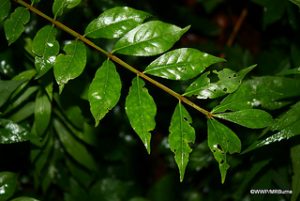Burning Bush
(Euonymus alatus)
Family: Bittersweet Family (Celastraceae)
Native Range: Japan and Central China
 Burning bush, or winged spindletree, grows as a deciduous shrub up to 12 feet tall. Corky ridges form along the green twigs, and give the branches a winged appearance. The leaves are opposite and are elliptical in shape with toothed margins, and turn a brilliant scarlet in the fall. Inconspicuous greenish flowers occur in late spring, and red-purple fruits mature during summer.
Burning bush, or winged spindletree, grows as a deciduous shrub up to 12 feet tall. Corky ridges form along the green twigs, and give the branches a winged appearance. The leaves are opposite and are elliptical in shape with toothed margins, and turn a brilliant scarlet in the fall. Inconspicuous greenish flowers occur in late spring, and red-purple fruits mature during summer.
Look-alikes
Burning bush may be confused with other species of euonymus.
Ecological Threat
Burning bush threatens a variety of habitats including forests, coastal scrublands and prairies. It is tolerant of moist soils, and can occur in wetlands.
Burning bush replaces native shrubs in some woodland habitats and alters the structure of natural plant communities. It can form dense thickets, displacing many native woody and herbaceous plant species.
Distribution and Background
Burning bush was imported from Northeastern Asia in the 1860s.
Burning bush is found from New England to northern Florida and the Gulf Coast and also in Illinois.
Alternative Plants (Alternative native Species)
Many native plants make excellent substitutes for exotic bush burning bush. Some examples include:
- Black chokeberry (Aronia melanocarpa)
- Sumac (Rhus aromatica, Rhus typhina)
- Highbush blueberry (Vaccinium corymbosum)
Whenever possible, use as alternatives plant species that are native and adapted to the ecological region where you live. They will be more valuable to the wildlife species that have evolved with them and depend upon them for food and shelter. Check with your local native plant society for recommendations and sources of native plants.
Biology and Spread
 Burning bush spreads easily by root suckers. The fruits of burning bush are dispersed by birds.
Burning bush spreads easily by root suckers. The fruits of burning bush are dispersed by birds.
Management Options
Mechanical and chemical methods are the primary means of control of burning bush.
For disposal options, refer to the control and disposal options page.
Plant Control
Manual, mechanical and chemical means are available to control established plantings.
Biological
At this time no means of biological control is available for controlling burning bush.
Manual
Remove young seedlings by hand before they produce seeds. Seedlings are best pulled after a rain when the soil is loose. Remove the entire root system to avoid resprouting.
Mechanical
Cutting or mowing is effective in controlling burning bush. Cutting is most effective when combined with an application of herbicide to cut surfaces.
Stems should be cut at least once during the growing season, and as close to ground level as possible.
A tool such as a weed wrench can be very effective in uprooting plants from the soil.
Chemical
Apply systemic herbicides like glyphosate and triclopyr to control burning bush. Make sure to use a wetland formulated herbicide such as Rodeo, Accord Concentrate, or Garlon 3A if you are working in a wetland.
Caution: Applying herbicides to control invasive plants on property you do not personally own requires a pesticide applicator’s license issued by the state. A pesticide applicator’s license is required to use herbicides on public and private conservation lands.
Caution: Any activities in wetlands (from removing invasives by hand or by applying herbicides) may require a special permit under the Wetlands Protection Act and/or your local bylaws. Be sure to contact your local Conservation Commission before you act.
Notice: Mention Of Pesticide Products On This Web Site Does Not Constitute Endorsement Of Any Material.
More Information
For more information on invasive species in Massachusetts, refer to the Massachusetts Prohibited Plant List at https://www.mass.gov/massachusetts-prohibited-plant-list.